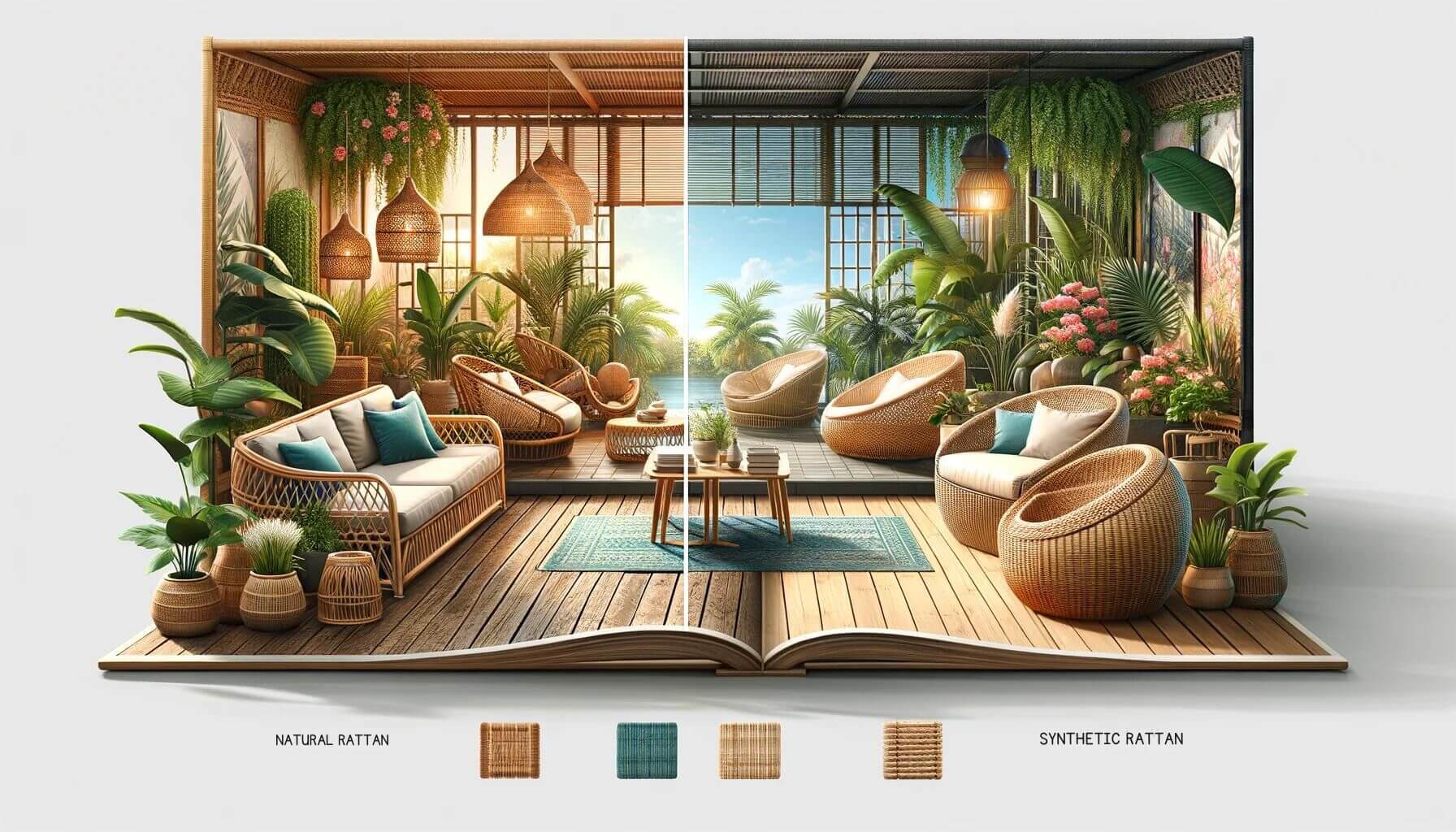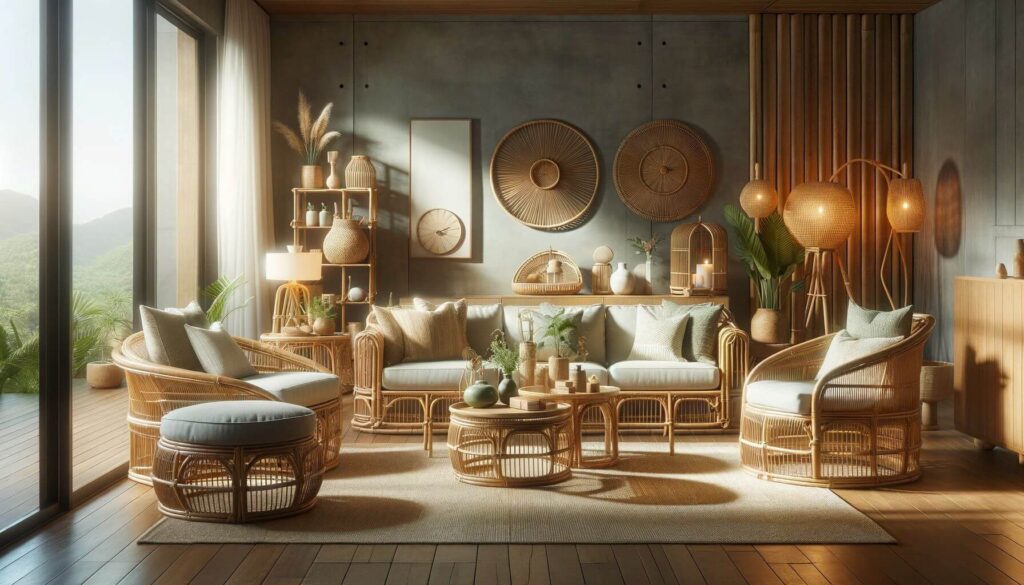
Rattan stands as a testament to the harmony between nature’s artistry and human ingenuity. Beyond its woven charm and versatility in design, rattan emerges as a pioneer of sustainability in the realm of furniture.
Amidst a global shift towards environmental consciousness, this material captures the hearts of eco-aware individuals. The growing appetite for home decor that aligns with eco-friendly practices underscores rattan’s significance, positioning it as a preferred choice for those seeking elegance without compromising the planet’s health.
From Natural Origins to Rattan Furniture
Thriving under the canopy of tropical rainforests, rattan’s journey begins. This slender vine, capable of majestic heights, flourishes quickly, making it a resource that renews faster than it’s consumed. Unlike the deforestation associated with timber, rattan’s harvest leaves a gentle footprint on its natural habitat, This is an example of how we can utilize resources respectfully and responsibly.
Sustainable Harvesting Practices
The art of harvesting rattan is steeped in tradition, passed down through generations of forest communities. These custodians of the forest employ techniques that ensure the vitality of the rattan palms and the ecosystems they support are preserved. By cutting only mature vines and leaving the younger ones to grow, they uphold the principles of sustainable management.
This careful stewardship not only maintains the balance of the forest but also ensures a continuous supply of this valuable material, securing the future of rattan furniture and the communities dependent on its harvest.
Environmental Impact of Rattan Furniture
Biodegradability
In a world grappling with pollution and waste, rattan furniture emerges as a beacon of environmental responsibility. Its inherent biodegradability sets it apart from synthetic alternatives that linger in landfills for centuries.
Once a rattan piece reaches the end of its lifecycle, it can gracefully return to the earth, decomposing without leaving harmful residues behind. This cycle of life and rebirth starkly contrasts the enduring environmental toll of plastics and other non-biodegradable materials, highlighting rattan’s role in fostering a more sustainable future.
Carbon Footprint
The journey of rattan from the dense foliage of tropical forests to elegant furniture pieces treads lightly on the planet. The entire process, from the low-impact harvesting methods to the crafting of furniture, is marked by a relatively low carbon footprint.
Unlike the energy-intensive production of synthetic materials, rattan processing is predominantly manual, requiring minimal machinery and fossil fuel consumption. This gentle approach not only preserves the vibrancy of ecosystems but also contributes to the reduction of global carbon emissions, making rattan an ally in the fight against climate change.
Rattan and Biodiversity
Supporting Ecosystems
Sustainable rattan harvesting is not just about securing the material for future use; it’s a nuanced dance with nature that supports the intricate web of forest biodiversity. By adhering to practices that prevent overharvesting and promote regrowth, these methods help maintain the forest canopy structure and habitat complexity essential for a myriad of species. This careful balance ensures that the forests continue to thrive, serving as a vital reservoir of biodiversity and a bulwark against the biodiversity crisis.
Community Impact
Beyond its environmental benefits, rattan also weaves a thread of economic sustainability through the communities it touches. For many rural inhabitants of tropical regions, rattan harvesting offers a lifeline, providing a source of income that encourages the preservation of forests.
This symbiotic relationship between people and nature fosters a sense of stewardship and supports sustainable development goals, including poverty alleviation, sustainable livelihoods, and community resilience. Through the lens of rattan, we see a model of how sustainable natural resource management can uplift communities while safeguarding the environment.
Rattan Furniture: A Choice for the Eco-conscious Consumer
Durability and Longevity
In an era where the throwaway culture has become all too common, rattan furniture stands out for its remarkable durability and longevity. This resilience is not just a mark of quality; it’s a testament to rattan’s sustainability. When consumers choose rattan, they invest in furniture that withstands the test of time, reducing the need for frequent replacements.
This longevity means less furniture waste ending up in landfills, making rattan an ally in the pursuit of a more sustainable living environment. By opting for rattan, eco-conscious consumers actively contribute to a cycle of use that values persistence and purpose over disposability.
Recycling and Upcycling Opportunities
Rattan furniture’s journey doesn’t end when its initial purpose is fulfilled. The material’s natural flexibility and strength make it an ideal candidate for recycling and upcycling projects. So, creative minds can breathe new life into old rattan pieces, transforming them into something fresh and functional.
This adaptability will extends the lifecycle of rattan products and also embodies the principles of a circular economy. So these materials are reused and repurposed to minimize waste. The potential for recycling or upcycling rattan furniture further cements its status as an environmentally friendly choice, offering endless possibilities for those looking to infuse their spaces with both beauty and a commitment to sustainability.
Future of Sustainable Rattan

Innovations in Rattan Production
The horizon for rattan cultivation and production is bright with ongoing research and innovations aimed at enhancing its sustainability. Scientists and environmentalists are collaborating to develop new methods of cultivation.
The goal is to increase yield while ensuring the health of forest ecosystems. Also, these initiatives include the introduction of more efficient, eco-friendly processing techniques that reduce water and energy use.
Moreover, there’s a growing focus on genetic studies to identify rattan species that can be cultivated more sustainably and with greater resilience to changing climate conditions. These advancements promise to further solidify rattan’s position as a leading material in the sustainable furniture market.
Certifications and Standards
As the demand for sustainable products grows, so does the importance of transparency and accountability in production practices. Consumers looking to make responsible choices can seek out rattan furniture that bears certifications and adheres to recognized sustainability standards.
Certifications like the Forest Stewardship Council (FSC) signify that the rattan has been harvested according to environmentally and socially responsible practices. If you priorite these credentials, you can support a more sustainable rattan industry. You will also contribute to the preservation of natural resources. This is important for the well-being of communities who produce rattan.
The Sustainability Aspect of Rattan Furniture
Choosing rattan furniture represents much more than an aesthetic preference; it’s a conscientious decision reflecting a commitment to environmental stewardship. The journey of rattan, from the heart of tropical forests to our homes, is imbued with qualities that echo the principles of sustainability, durability, biodegradability, and a minimal environmental footprint. As we move forward, innovations in rattan production and a focus on certification standards promise to enhance these qualities further.
When we embrace rattan in our spaces, we enrich our living environments with its natural elegance. We also align our consumer choices with the health of our planet.
Rattan furniture stands as a testament to the possibility of merging style with sustainability. This offer a pathway to a more mindful and eco-friendly lifestyle. In considering the broader impacts of our furniture choices, let us lean towards options like rattan that offer a harmonious blend of beauty, durability, and environmental respect.



